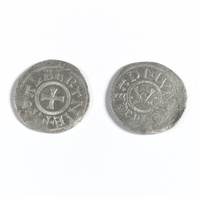
Viking Objects
Reproduction Viking Silver Penny
This reproduction of a Viking silver penny immitates those minited bu the Vikign rulers of York in the tenth century. Viking rulers in the Danelaw eventually took up the Anglo-Saxon practice of minting coins which helped legitimise their authority.
Read More

Viking Names
Thormund
Þormundr is probabably an Eastern Scandinavian make personal name formed from Old Norse Þór- ‘the god’s name Þór’ and Old Norse –mundr ‘protector’. It is rare in Sweden, but a number of instances are recorded in Denmark including the form þurmutʀ in a runic inscription from the early Viking Age. The name was not found in West Scandinavia until the sixteenth century. Some forms of the place-name Thurmaston, Leicestershire seemed to be influenced by Þormundr in the thirteenth and fourteenth centuries.
Read More
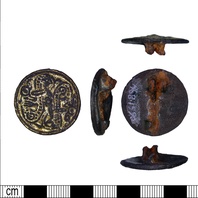
Viking Objects
Copper-Alloy Jellinge-Style Brooch (LEIC-36241D)
This brooch contains two S-shaped zoomorphic Jellinge-style designs around a central boss. For more information on Scandinavian jewellery in England check out our blog: Brooches, Pendants and Pins: Scandinavian Dress Accessories in England.
Read More
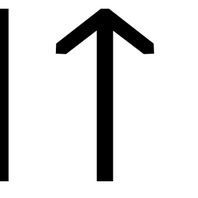
Viking Names
Ketil
The Old Norse male name Ketill is widely used across the Scandinavian world, including the Viking diaspora. It is also common as an element in compound names such as Grímketill (in later times usually appearing in a reduced form as Grímkell) or Ketilbjörn. In place-names it occurs for example in Kedleston, Derbyshire, Ab Kettleby, Leicestershire and several names in Lincolnshire such as Ketsby and Kettlethorpe. The name is identical to the common noun ketill meaning ‘kettle, cauldron’, which is a loan-word from Latin catillus (a ‘small basin’ or ‘bowl’) in Germanic languages. This suggests it was originally a by-name and there are many suggestions as to how such a by-name might have come about, including because someone had a head shaped like a cauldron, or wore a cauldron-shaped helmet, or engaged in ritual activities using a cauldron. In any case, by the Viking Age it is well established as a given name, without obvious reference to its meaning. The element is frequent in the Danelaw, both as a name and as the first element of place-names. Occasionally, the place-names may contain the Old English cognate cetel/cietel/cytel, used topographically for a deep valley surrounded by hills, and often associated with springs or streams. Its use as a personal name, however, seems to have been introduced by the Scandinavians.
Read More
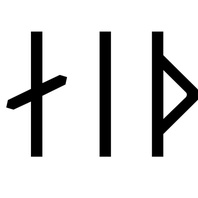
Viking Names
Hreidar
The Old Norse male personal name Hreiðarr is very common in Norway but relatively uncommon elsewhere in the Viking world. It can be found as the first element in the place-name Rearsby, Leicestershire. It also features as the name of the main character in the short tale of Hreiðarr the Foolish.
Read More
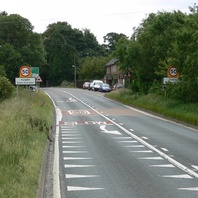
Viking Names
Tugby
Tugby, in the East Goscote Hundred of Leicestershire, is a Scandinavian compound from the Old Norse male personal name Tóki and Old Norse by ‘a farmstead, a village’. In the Domesday Book, a Tochi is recorded as holding Tugby as part of a larger estate. It is now a joint parish with Keythorpe.
Read More
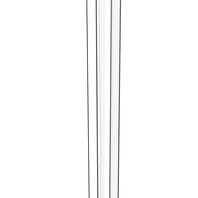
Viking Designs
Drawing of a Viking Sword
This is a drawing of a Viking Age sword which was found in Grave 511 at Repton where the invading Viking Great Army had their winter camp in 873/4. When it was found, the sword had traces of a wooden scabbard attached to the rusted blade. Analysis showed that the scabbard was lined with fleece and covered in leather. The grip was wooden and covered in a woollen textile.
Read More
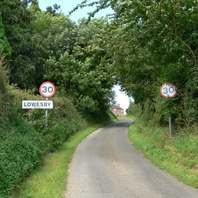
Viking Names
Lowesby
Lowesby, in the East Goscote Hundred of Leicestershire, is a difficult name. The first element possibly comes from the Old Norse male byname Lauss/Lausi ‘loose-living’. Alternatively it has been suggested that the first element could be derived from the postulated Old Norse element lausa ‘a slope’ which is found in Scandinavian place-names in the forms -lösa/-löse; however, this element was no longer used for place-naming by the time of Scandinavian settlement in England. The second element is Old Norse by ‘a farmstead, a village’.
Read More
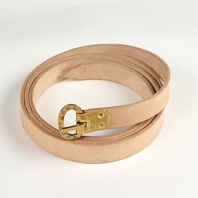
Viking Objects
Reproduction Belt
A vegetable-tanned leather belt with a decorated copper alloy belt buckle. The buckle has a ring and dot pattern and is based on one found in Grave 511 at Repton, Derbyshire.
Read More
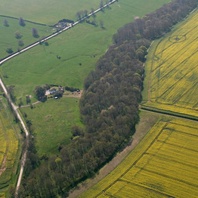
Viking Names
Beesby
Beesby, in the Bradley Haverstoe Wapentake of Lincolnshire, comes from a male personal name Besi and the Old Norse element by ‘a farmstead, a village’. The name Besi, which is recorded for Lincolnshire in Domesday Book, seems to be a Danelaw version of a Scandinavian name recorded in Old Danish as Bøsi. Today the name survives only in Beesby Farm and Beesby Hall, but remains of a deserted medieval village can be seen.
Read More
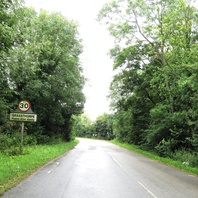
Viking Names
Grassthorpe
Grassthorpe in the Thurgarton Wapentake of Nottinghamshire is an Old Norse compound from gres ‘grass’ (which could also be Old English) and þorp ‘a secondary settlement, a dependent outlying farmstead or hamlet’.
